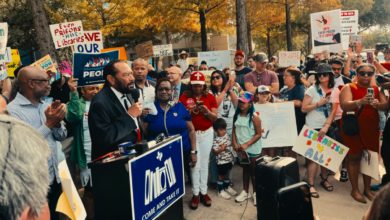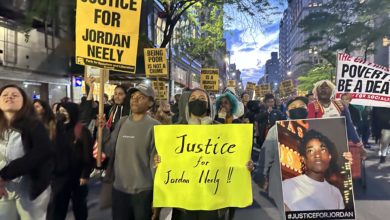In front of a white judge and an all-white jury in Jena, La., 17-year-old Mychal Bell was convicted of aggravated battery and conspiracy to commit aggravated battery. He now faces up to 22 years in prison for his alleged involvement in a schoolyard fight. Bell will be sentenced on July 31.
Five other Black youth are charged with similar crimes, and are awaiting trial.
|
The trouble began in Jena—a town of 3,000, where only 350 are Black—in September 2006. During a scorching hot day, a Black student decided during lunch to sit under a tree. It was known as a place where only white students congregated.
The following day, three nooses appeared in school colors, hanging from the branch of that same “white tree.” This was a message that the “white tree” would be reserved for whites, not only by tradition but also by force.
“It meant the KKK, it meant ‘n*****s we’re going to kill you, we’re gonna hang you ‘til you die,’” said Caseptla Bailey, mother of one of the Jena Six. (BBC News, 2007)
The three white students responsible for this racist act of terror were slapped on the wrist—they were suspended from school for three days. The school’s white superintendent explained, “Adolescents play pranks. I don’t think it was a threat against anybody.”
Black students at Jena high school decided to fight back, organizing a sit-in under the tree. The school responded to the protest by calling the cops and the county’s district attorney, Reed Walters. Walters threatened the protesting Black students with jail time for making an issue of this “prank.”
According to Michelle Rogers, one of the few Black teachers at Jena High School, Walters threatened the students. Walters said, “I could end your lives with the stroke of a pen.”
Arresting the victims
On the night of Nov. 30, 2006, a still unsolved fire burned down the main academic building of Jena High School.
On Dec. 1, Robert Bailey, a Black student, attended an all-white party by invitation. He was attacked and beaten by a crowd. When the police showed up, they told Robert and his friends to “get back to their side of town,” according to Caseptla Bailey, Robert’s mother.
The next day, Bailey ran into one of his white attackers, Matt Windham, at a convenience store. Words were exchanged, and Windham pulled out a sawed-off shotgun. Bailey and other Black men with him successfully wrestled the gun from Windham’s hands. They then fled the scene. Windham was not arrested.
On Dec. 4, another of Bailey’s attackers, Justin Baker, was openly defending the white students who had hung the nooses. Baker was freely using the word n****r. He was doing this on the campus of Jena High School.
In response, several Black students roughed up Baker, who was taken to the hospital and released the same day. He was well enough to attend a social function that same night.
The Jena police did not arrest Baker for inciting racist violence against Black students. Instead, they arrested six Black high school students who fought with Baker.
The six, now known as the Jena 6—Robert Bailey, Theo Shaw, Carwin Jones, Bryant Purvis, Mychal Bell, and a still unidentified minor—were charged with attempted second-degree murder and conspiracy to commit murder.
All six students were expelled from school.
Bail was set between $70,000 and $138,000 for each of the Jena 6. Many of the young men suffered in jail for months because their parents could not afford to bail them out.
Bell remained in jail from December 2006 until his trial in June 2007. He was the first to go to trial. Shaw also has remained in jail.
With no evidence of attempted murder, the district attorney lessened the charges against Bell to aggravated battery. In Louisiana, this charge requires the use of a dangerous weapon in the underlying attack. The prosecution claimed that the students—he called them the “gang of Black boys”—used their sneakers as a dangerous weapon. The court allowed this spurious argument.
Despite the clear miscarriage of justice, Bell’s court-appointed lawyer did nothing to challenge the charge. He called no witness and failed to introduce essential evidence on Bell’s behalf.
Bell’s father, Marcus Jones, later said they had “come to find out that [the court-appointed lawyer] was working with the DA to get my son convicted.” (Democracy Now, July 10)
Lynch terror
The Jena 6 case must be seen in the history of entrenched racism in the South. After the overthrow of chattel slavery,
|
Lynchings served to enforce the second-class status of Blacks in the South and Midwest. Black people endured the worst jobs, the most difficult living conditions, and the lowest pay.
Racist violence was used to ensure that Black people would be less inclined to fight back against the terrible oppression.
Lynchings usually consisted of all sorts of vile torture, including the burning, skinning or disembowelment of victims before they were hanged. They were often a community event. Most pictures of lynchings show large crowds, usually with people smiling, as a Black body hangs in the background.
History is replete with examples.
The summer of 1919 is known as Red Summer, for the hundreds of Blacks murdered by white racist mobs in 26 cities.
In 1955, 14-year-old Emmett Till was found weighted down in a lake with his face so badly beaten it was unrecognizable. Till was brutally murdered for allegedly whistling at a white woman.
After the fall of Jim Crow, lynchings became less prevalent, but the racism fueling them has not subsided. In 1998, three white men in Jasper, Texas, picked up James Byrd, beat him, slit his throat, and dragged him behind their truck for three miles.
Jena is another example of the racist terror that still exists in the South, especially in rural impoverished areas. Yet, the Jena district attorney and school superintendent called a direct allusion to lynching a schoolyard “prank.”
The implication is that Black people should not worry about racist violence. But as a tradition that murdered and maimed tens of thousands of Black people, one thing is clear: lynching is no joke.
Fighting back
The Jena 6 case highlights the virulent racism that still exists in the United States today.
In the town of Jena, like thousands of other towns and cities in the South, racism is the dominant form of social control. It emanates from the institutions of the capitalist state and the existing white power structure.
The six young Black men who were arrested for a schoolyard fight should be set free immediately. All charges should be dropped now. The verdict in Bell’s trial should be vacated and he should be released. The Jena 6 have committed no crime.
The schoolyard fight with the racist Baker should not be held against them. These fights happen frequently in schools all over the United States—rarely, if ever, do they result in murder or battery charges being levied against anyone.
In this case, the fight was understandable. The Jena 6 were provoked by the overwhelming atmosphere of racism and threatened violence against Black students in Jena.
It is reasonable for every Black student at Jena High School to fear that racist violence might target them at any time. They have the absolute right to defend themselves against those who promote hate crimes.
Progressive people across the country must rally to the defense of these young men. They are fighting an uphill battle against a Jim Crow legal system in a racist town. The Jena 6 need the support of a determined, nationwide struggle to set them free.
Send financial contributions to the Jena 6 Defense Committee, PO Box 2798, Jena, LA 71342.








